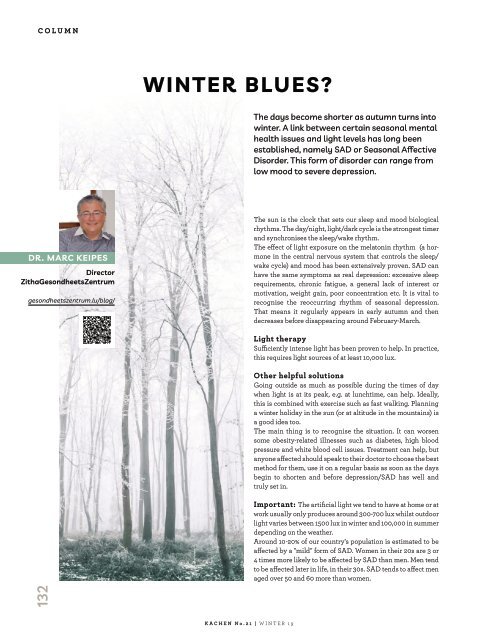KACHEN #21 (Winter 2019) English edition
- No tags were found...
Create successful ePaper yourself
Turn your PDF publications into a flip-book with our unique Google optimized e-Paper software.
COLUMN<br />
WINTER BLUES?<br />
The days become shorter as autumn turns into<br />
winter. A link between certain seasonal mental<br />
health issues and light levels has long been<br />
established, namely SAD or Seasonal Affective<br />
Disorder. This form of disorder can range from<br />
low mood to severe depression.<br />
DR. MARC KEIPES<br />
Director<br />
ZithaGesondheetsZentrum<br />
gesondheetszentrum.lu/blog/<br />
The sun is the clock that sets our sleep and mood biological<br />
rhythms. The day/night, light/dark cycle is the strongest timer<br />
and synchronises the sleep/wake rhythm.<br />
The effect of light exposure on the melatonin rhythm (a hormone<br />
in the central nervous system that controls the sleep/<br />
wake cycle) and mood has been extensively proven. SAD can<br />
have the same symptoms as real depression: excessive sleep<br />
requirements, chronic fatigue, a general lack of interest or<br />
motivation, weight gain, poor concentration etc. It is vital to<br />
recognise the reoccurring rhythm of seasonal depression.<br />
That means it regularly appears in early autumn and then<br />
decreases before disappearing around February-March.<br />
Light therapy<br />
Sufficiently intense light has been proven to help. In practice,<br />
this requires light sources of at least 10,000 lux.<br />
Other helpful solutions<br />
Going outside as much as possible during the times of day<br />
when light is at its peak, e.g. at lunchtime, can help. Ideally,<br />
this is combined with exercise such as fast walking. Planning<br />
a winter holiday in the sun (or at altitude in the mountains) is<br />
a good idea too.<br />
The main thing is to recognise the situation. It can worsen<br />
some obesity-related illnesses such as diabetes, high blood<br />
pressure and white blood cell issues. Treatment can help, but<br />
anyone affected should speak to their doctor to choose the best<br />
method for them, use it on a regular basis as soon as the days<br />
begin to shorten and before depression/SAD has well and<br />
truly set in.<br />
Important: The artificial light we tend to have at home or at<br />
work usually only produces around 300-700 lux whilst outdoor<br />
light varies between 1500 lux in winter and 100,000 in summer<br />
depending on the weather.<br />
Around 10-20% of our country's population is estimated to be<br />
affected by a "mild" form of SAD. Women in their 20s are 3 or<br />
4 times more likely to be affected by SAD than men. Men tend<br />
to be affected later in life, in their 30s. SAD tends to affect men<br />
aged over 50 and 60 more than women.<br />
132<br />
<strong>KACHEN</strong> No.21 | WINTER 19


















